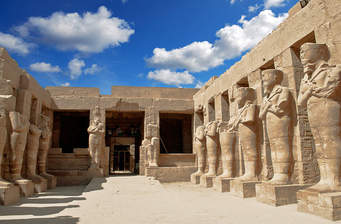LUXOR, Egypt, April 20 (NNN-MENA) – The Egyptian Ministry of Antiquities, opened Opet Temple for the first time for visitors on Friday, after its recent restoration at Karnak Temple Complex on the Nile River’s east bank, in Upper Egypt’s monument-rich province of Luxor.
Antiquities Minister, Khaled al-Anany, and Tourism Minister, Rania al-Mashat, inaugurated the temple in a ceremony witnessed by Mostafa Waziri, head of Egypt’s Supreme Council of Antiquities, and a number of Egyptian parliamentarians, celebrities and public figures, as well as, some foreign diplomats.
“The temple was first built during the New Kingdom, under the reign of the 18th Dynasty and was completed in the Late Period and the Ptolemaic Period, a few centuries BC,” Mostafa al-Saghir, director-general of Karnak temples in Luxor, said.
He pointed out that the temple was dedicated to the worship of hippopotamus goddess Opet, the diety of protection in ancient Egypt, “who was also considered the torch bearer goddess that lit up the afterlife darkness.”
Opet Temple is characterised by its unique and colourful inscriptions, which were covered by soot that has been carefully removed during the restoration process, according to Saghir.
The inauguration of the temple is part of Egypt’s celebration of the World Heritage Day, an international day for monuments and sites celebrated on April 18 each year, since it was approved by the UNESCO in 1983.
On Thursday, Egypt started the World Heritage Day activities by announcing a newly discovered massive 3,500-year-old tomb with 18 entrance gates at the necropolis, on the west riverbank in Luxor.
The rock-cut tomb, or “saff” tomb as known in Egypt, belonged to a man called Shedsu-Djehuty, who was a prince, a mayor and a royal seal holder in ancient Egypt; he might have served under King Thutmose I, some 3,500 years ago.
Later on Thursday evening, the Ministry of Antiquities unveiled a 60-tonne, 12-metre-tall statue of ancient Egyptian King Ramses II, after its restoration and re-erection, standing next to five other statues at the pylon of Luxor Temple, on the east riverbank.– NNN-MENA




